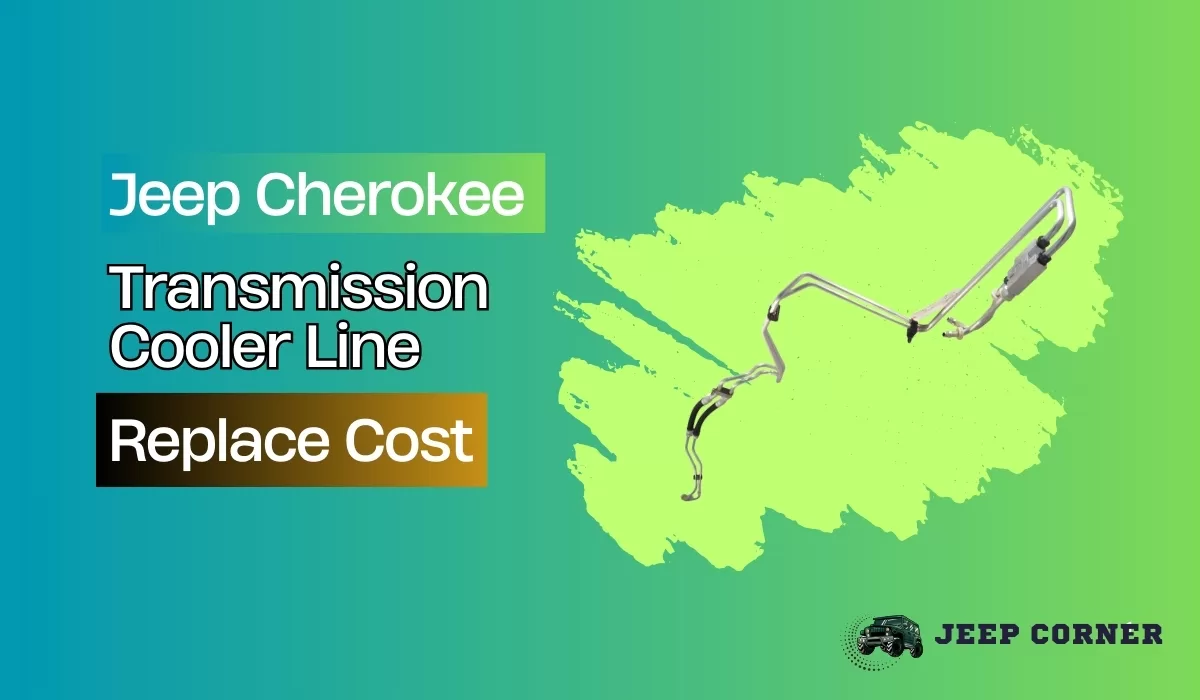Jeep Cherokee Transmission Cooler Line Replace Cost- Find Out How Much You’ll Shell Out
Have you ever had your Jeep Cherokee transmission fail? No one wants to be stuck in the middle of nowhere with a dead transmission, but it happens. If you or someone you know has had this experience, you know the solution: replacing the transmission cooler line.
So, what’s the Jeep Cherokee transmission cooler line replace cost? It will cost you between $100 to $450 inclusive of new lines and labor. Each model has its transmission cooler line, and its price is different. We cannot give you the exact figure as the cost of buying a new transmission cooler line depends on the model you own.
Read on to know the actual cost of replacing your Jeep Cherokee transmission cooler line, how to do a replacement, and much more.
Table of Contents
An Overview of Jeep Cherokee Transmission Cooler Line Replace Cost
Here is a table illustrating the costs associated with replacing your transmission cooler line.
Keep in mind that these are just estimates. The real cost of the replacement will vary based on your location and the quality of the replacement. Also, the costs listed below do not include labor. Nevertheless, depending on your mechanic, this will cost you between $100 to $300.
| Generation | Car Model Years | Cost of new replacement |
| First generation | 1992 to 1996 | $42 to $55 |
| Second generation | 1997 to 2001 | $33 to $60 |
| 2002 to 2013 (No production) | $0 | |
| Third generation | 2014 to 2022 | $45 to $120 |
Signs that indicate to replace your transmission cooler line
Here are the signs that will tell you it’s time to replace that old transmission cooler line:
- Leaking transmission cooler fluid
The most common reason that you need to replace your transmission cooler line is if it is leaking. When you have a leak, the transmission fluid will seep out of the transmission cooler lines.
Leaks are common where the lines connect to your radiator. Check this place for red fluid. If you see a red fluid leakage, you need to get your transmission cooler lines replaced immediately.
- Low level of cooler fluid
Low levels of transmission cooler fluid indicates a leak in your transmission cooler lines.
The first thing to do when you suspect a leak is to check the transmission fluid level in your car’s reservoir. This can be done by looking at the dipstick, which will tell you how much fluid is in the reservoir at any given time.
If it’s low, this could mean that you have a leak somewhere else in your transmission system and need to fix it before replacing the cooler lines themselves.
However, if there is no leak—and you still think there might be one—you can try to find the leak by checking under the hood for signs of corrosion or other damage to the transmission system. If you find any signs of corrosion, it’s time to change your transmission lines.
- Visible defects in your lines
If you notice signs of holes or tears in your cooler lines, it may be time to replace them. Holes and tears can lead to leaks and wear that can damage your transmission and cause premature failure.
Likewise, if you see signs of corrosion on these parts, they need to be replaced immediately. The longer they sit around with rust, the more damage they will do over time!
- Noisy transmission
If you’re noticing your transmission is making noise when you’re at speed (or even just idling), it’s time to replace your transmission cooler line. However, several different things can cause a noisy transmission. But the main culprits are dirty or worn-out transmission fluid and a faulty cooling system.
Transmission fluid is what keeps your engine lubricated and running smoothly. It’s a mix of water and antifreeze, so if it gets contaminated with dirt or oil, it can cause problems with your car’s drivetrain. The result is an audible clunking noise as you accelerate or decelerate.
- Delayed shifting response
Transmissions with a delayed shifting response can be one of the most frustrating problems. This occurs when your transmission operates at higher temperatures than normal. So due to this, it doesn’t respond quickly enough to the input from the clutch pedal or gas pedal.
And you’ll notice this when you try to shift into a gear—the transmission won’t engage until after you’ve already applied pressure on the gas pedal. The longer your transmission responds, the more likely you’ll need a new cooler line.
- Burning smell from overheated transmission
If you notice a burning smell coming from your transmission, you may need to replace the transmission cooler line. This is because it is the connection between your transmission and your radiator.
If the line is damaged or broken, it can lead to overheating of the transmission and cause damage to other parts of your car as well.
Can you drive with a malfunctioning transmission cooler line?
No, you can’t!
You have a malfunctioning transmission cooler line. This means that there is a leak in your transmission cooler line. It cannot transfer heat from the transmission fluid to the radiator as efficiently as it should.
Consequently, this can lead to overheating if you are driving at high speeds. Overheating will cause your engine to produce excessive amounts of heat. This will cause damage to your engine and other parts of your car if they aren’t cool enough (such as electrical components).
Can I replace the transmission cooler line by myself?
You can do this by yourself if you have extensive knowledge about cars. Follow the steps below to change your cooler lines:
Purchase the right replacement and coolant fluid
First, make sure to purchase a new transmission cooler line from your local auto parts store. You’ll need a length of hose that’s the same as the previous one. Similarly, you’ll also need a hose clamp on one end. The clamp will help keep you from losing any coolant that leaks out of the line.
Next, buy a new coolant fluid and get all the necessary tools needed for the job. This includes screws, spanners and so forth.
Drain the old transmission coolant
The next step is to drain the old transmission coolant. You can do this by opening your engine compartment and taking the hose off of the transmission fluid reservoir. You should then have an easy time draining the old fluid through a funnel into a container, such as a bucket.
Disconnect the lines
The transmission cooler lines are located at the back of the transmission, near the differential. To disconnect them, first ensure your car is off.
Then, take a flathead screwdriver and loosen each bolt connecting the lines to the transmission. You will likely need to use a ratchet or socket set. Once they are loose, pull them out from under their connecting clips and disconnect them from the transmission.
Install the new lines
It will be helpful if you have a friend to help you in this step.
To install the new line, fit it in your radiator and the other ends of the transmission. Screw it in place just like the old line. If requires, use rubber gaskets to seal the lines from leakages.
Refill the coolant
Your car manual should explain this step and how much coolant is needed. Generally, you need to mix the coolant and distilled water. Refill your radiator to the max line. Do not go past this line as the coolant expands due to heat from your engine.
Test your vehicle
Check for any leakages in the new lines and their joints. Start your car and take it for a test ride. All the symptoms of a bad cooler line should not be evident if you followed this procedure.
How often do you need to replace your transmission cooler line?
The transmission cooler line cools down the transmission fluid inside your Jeep Cherokee. Without proper cooling, your transmission will start overheating and potentially damage itself. This will set you back even further; then, you’ll have to replace the transmission and the cooler line.
So, you should replace the line when it has signs of wear and tear. The transmission cooler line is a rubber hose, so it will start to stretch out and wear down over time. There is no specific time or mileage to replace it. The line should be replaced whenever you notice it looks more worn than usual.
FAQs
Here are answers to some questions you might have:
Q: How long does it take to replace the transmission cooler line?
It depends on the complexity of your transmission. If you have a simple transmission (like an automatic) with one line, it will take less than a day to replace. If you have a more complicated transmission with multiple lines, it will take about two days to fully replace your transmission cooler line.
Q: How do I save money when replacing transmission cooler lines?
You can save the costs by doing the replacement by yourself. Besides, you should also source new lines from cheaper retailers. If you can’t DIY, you’ll have to find a cheaper mechanic.
However, we advise going for something other than a cheaper, and inexperienced professional. It would make sense to do the replacement at a dealership with a good reputation for quality repairs.
Final Thoughts
Your transmission cooler line is one of your engine’s most critical components. It acts as a conduit to transfer heat from the coolant to the transmission fluid, which in turn helps your air-cooled engine run at peak efficiency. If you have any visible defects in your lines, it’s time to replace them.
You can save replacement costs through DIY. All you have to do is follow the procedure in this write-up, watch a few YouTube videos, and you’re good to go. Moreover, remember to buy quality lines to avoid wear, tear and corrosion, which will necessitate another replacement.
You may also like
-
All You Need To Know About Jeep 3.8 Engine Replacement Cost
-
10 Common Jeep Engine Problems with Solution
-
How To Reset Check Engine Light On Jeep Wrangler: 6 ways
-
How to Reset Tire Pressure Light on Jeep Cherokee: Quick & Easy Guide
-
How to Manually Close Jeep Renegade Sunroof: Easy Step-by-Step Guide
-
How to Turn on Night Vision Jeep Grand Cherokee: Quick Guide








